Software RAID 1, or "Mirroring", makes an exact copy of all the data between two disks. So, when one of the drives fails - because HDD failure is a matter of time - all data is safe on the other disk. Let's create a software RAID 1 in Windows 7.
Unblock any international website, browse anonymously, and download movies and Mp3 with complete safety with CyberGhost, just for $2.75 per month:
To create software RAID 1 with Windows 7, we will need two hard disk drives - preferably of the same size - and at least Windows 7 Professional or Windows 7 Ultimate.
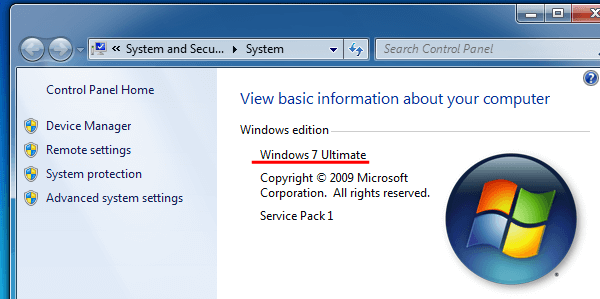
We can't create a software RAID 1 in Windows 7 Home Premium
Software RAID in Windows 7 is nothing less than a mess. Different Windows 7 versions have arbitrary restrictions on which RAID levels they allow us to create.
If we bought a PC with pre-installed Windows 7, we probably have Windows 7 Home Premium. That means that software RAID 1 is out of reach.
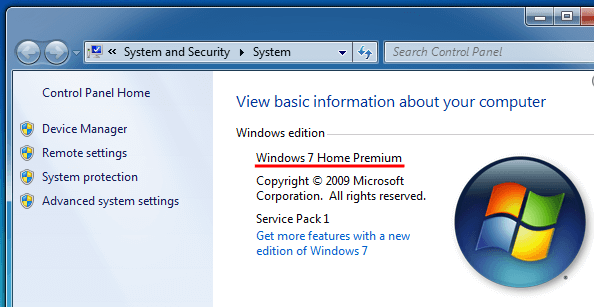
Due to licensing reasons, on Windows 7 Home Premium we can only create a RAID 0, "Striping", which is a useless type of RAID for data security.
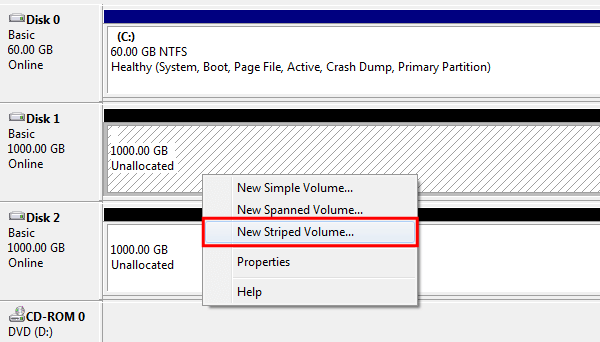
When one disk fails in the RAID 0, all the data from all the disks is lost, permanently and without any chance of recovery.
The "Spanned Volume" option isn't even RAID. It's a JBOD array (Just a Bunch of Disks), where two or more disks appear as a single large disk. But this too doesn't offer any data security, when one disk is lost, all the data from every disk in the array is lost.
So, we won't be covering either scenario in Windows 7 Home Premium.
Why software RAID 1 and not software RAID 5?
For the same arbitrary licensing reasons, software RAID 5 is completely off-limits to any version of Windows 7.
We will find the option by right-clicking on the drive, but it will always be grayed-out, just taunting us with what it would be...
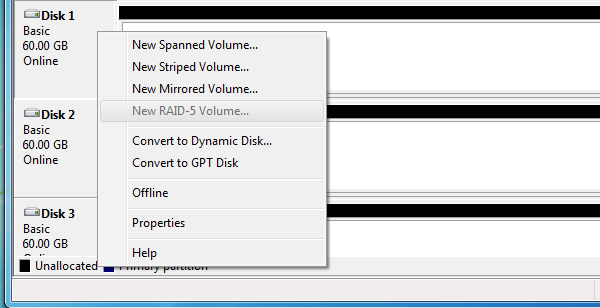
Only Windows Server editions - as old as Windows 2000 server - can create a software RAID 5.
With RAID 0 being useless for data security and RAID 5 being unavailable, creating a software RAID 1 in Windows 7 is the only viable option.
How to create a software RAID 1 in Windows 7
As we mentioned earlier, on a level 1 RAID two disks have the exact copy of all the data at any single moment. So, when one of them fails, the data is safe on the other.
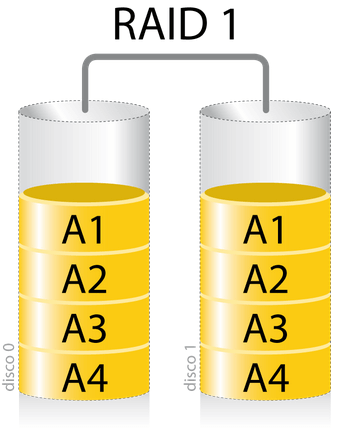
The downside of RAID 1 is that we lose 50% of the total disk capacity. If we use two 1TB disks for RAID 1, the array will have a 1TB capacity in total.
To create the software RAID, we press the Windows key + R, to open the "Run" dialogue, and type:
diskmgmt.msc

Creating a software RAID 1 with brand new disks
If both of the disks we will use for the Software RAID 1 are brand new, once we open the Disc Management console, we will get a message to initialize the disks.
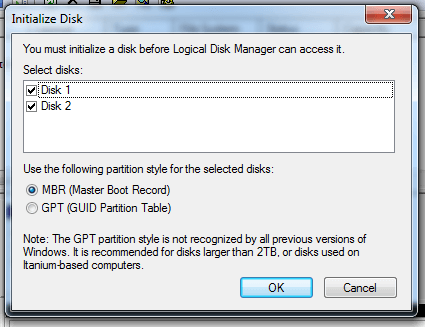
If the disks are smaller than 2TB each, the MBR partition style is good enough. Else, we need to select the GPT partition style.
After that, we right-click on one of the two unallocated volumes, and select "New Mirrored Volume...".
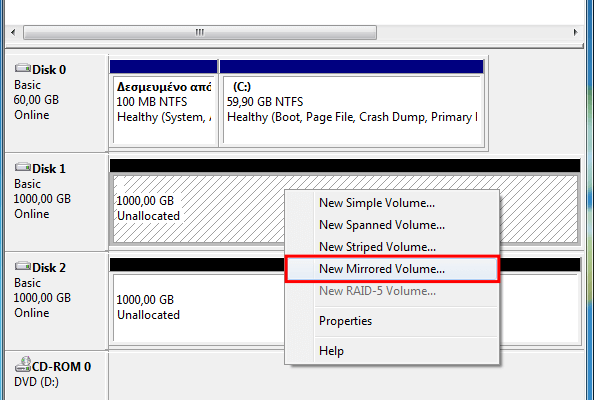
On the New Mirrored Volume Wizard, we add the 2nd disk...
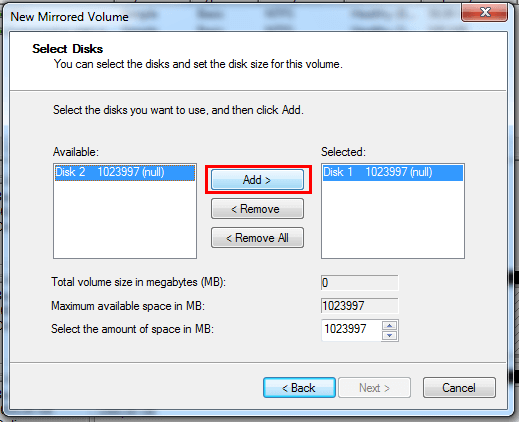
...which will allow us to move forward.
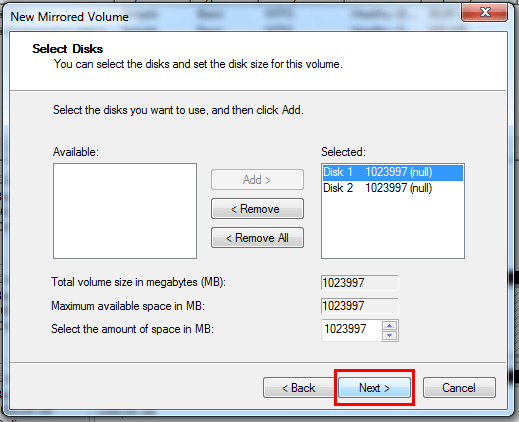
In theory, we can have more than two disks in a RAID 1 array, but they will all be copies of one disk, and a terrible waste of space. Four 1TB disks in RAID 1 give us a 1TB array, with 75% of the total capacity lost.
Finally, we assign a drive letter to the new array...
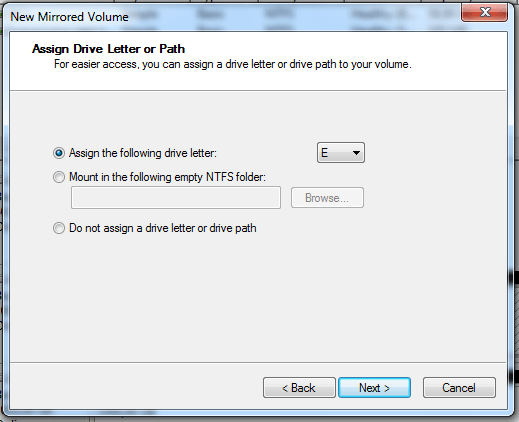
...and format it to NTFS.
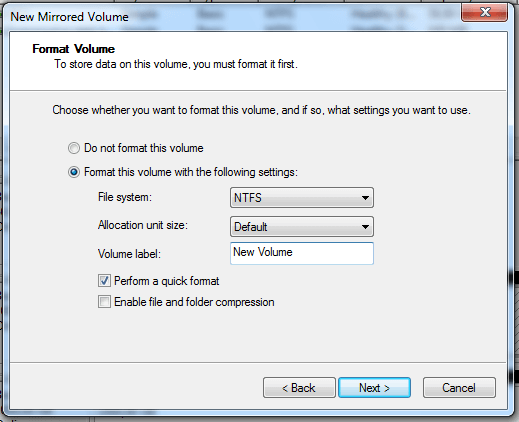
The system warns us that this operation will convert basic disks to dynamic. The only downside of that is that we can't dual-boot another operating system from a dynamic disk e.g. a Linux distribution or another version of Windows.
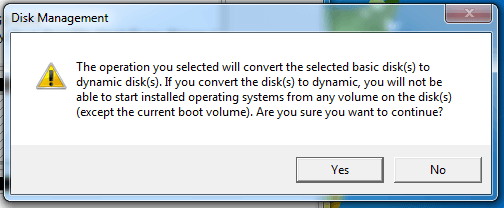
By choosing "Yes", our Software RAID 1 in Windows 7 is ready.
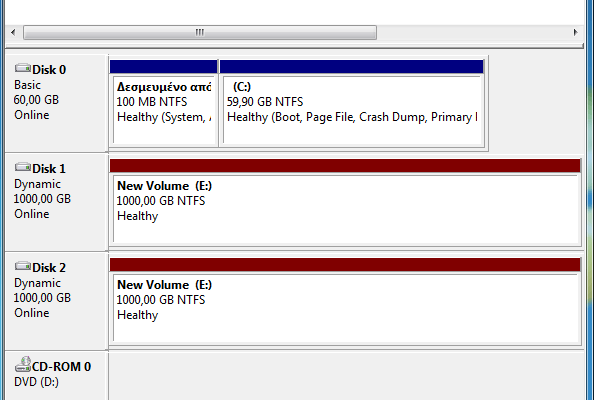
We will find it in the "Computer", as a single disk.
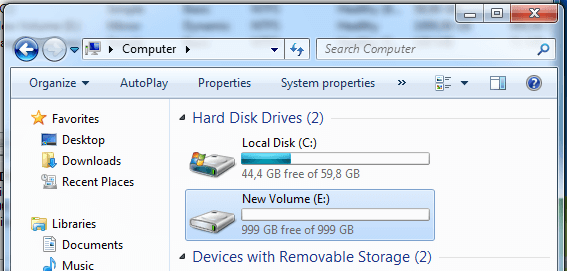
Creating a Software RAID 1 copy of an existing data disk or partition
Let's say we didn't buy two more disks but had already a disk or partition containing our data, and bought another disk to create a RAID 1.
In this case, we right-click the NTFS volume and select "Add Mirror...".
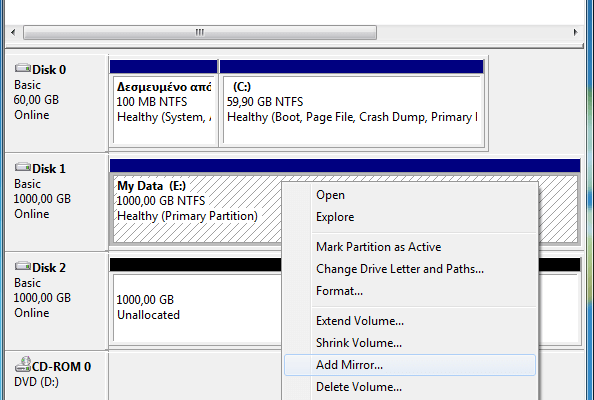
The system will show us the new disk, and we click on Add Mirror.
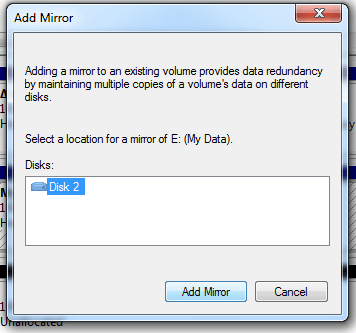
Both the disk we already had and the new disk will be converted to dynamic disks.
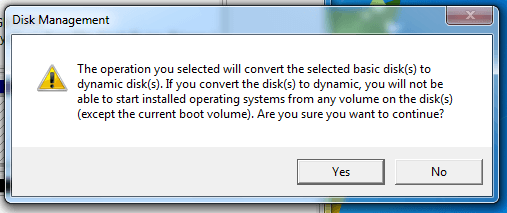
The software RAID 1 is created and starts resynching.
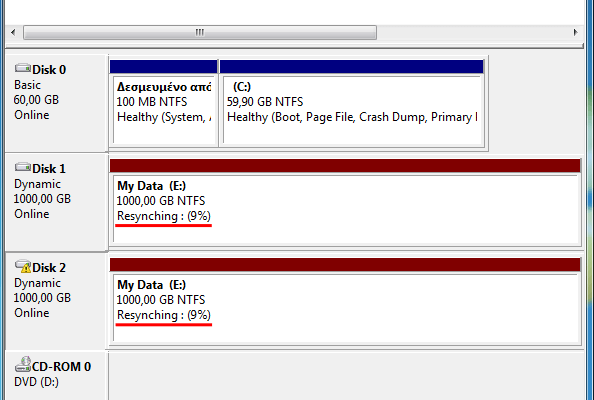
As you can see, the original data we had on the single disk isn't lost, and we have complete access to it while the RAID is resynching.
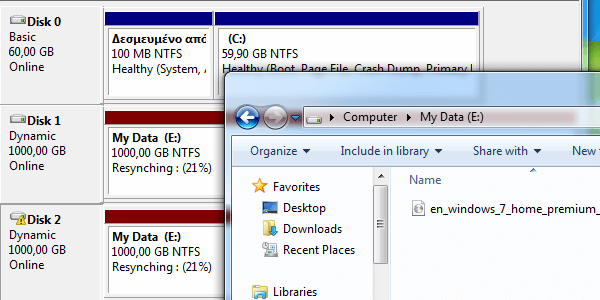
It's best to leave the RAID 1 resynching complete before we do any intensive writing or deleting of data. It is a strenuous procedure for the disks, and we shouldn't make it any harder. Disks are known to have failed during the RAID resynching.
Creating a Software RAID 1 for the Windows installation
Since we don't need to format both drives to create Software RAID 1, we can also create a RAID 1 with the Windows installation. But we shouldn't do this if we wish to dual-boot with another operating system, because of the dynamic disk restrictions we mentioned earlier.
We just need to mirror both the System Reserved partition...
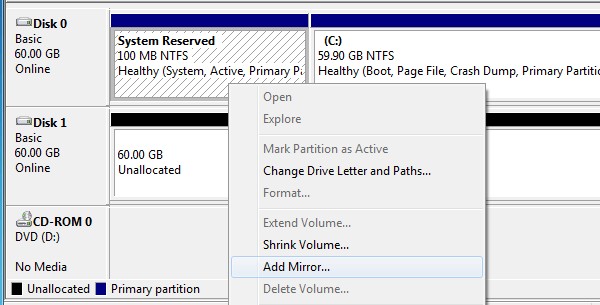
...and the C: partition.
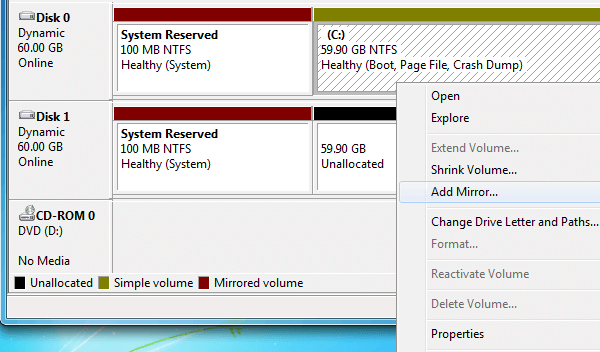
Mind you that if, for some reason, we don't have a "System Reserved" partition, it's impossible to create a bootable software RAID 1, the option will be grayed out.
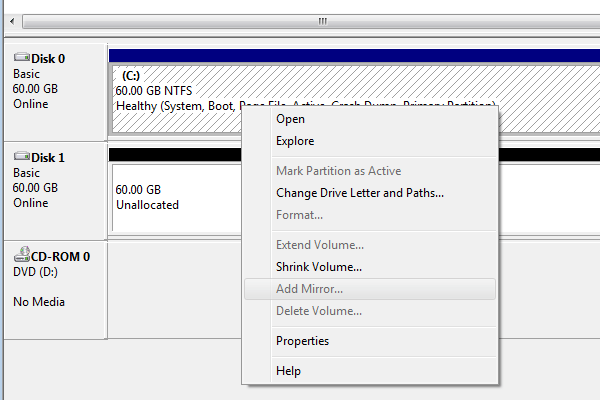
Now, on each system startup, we will get two boot options, one for each disk.
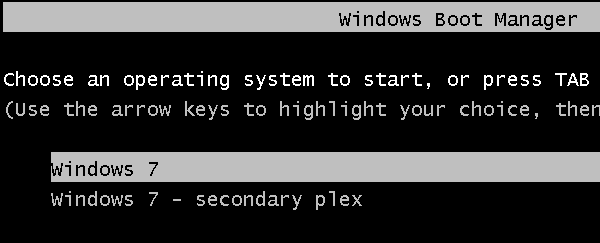
Both installations are identical, so it doesn't matter if we choose the "secondary plex" one.
What happens when one disk fails in RAID 1
When one of the hard drives does fail, we get a "Failed Redundancy" message at the Disk Management console.
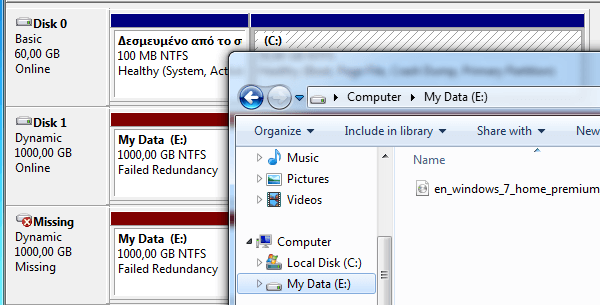
We still have complete access to our data, and nothing is lost provided the other disk still works properly.
Unfortunately, the system doesn't give us any warning whatsoever that one of the disks has failed.
This is a huge oversight, especially if we consider that a Linux Software RAID can send us an email as soon as a disk fails. But that's Microsoft for you.
We must make a habit of checking ourselves the Disk Management console every once in a while, to make sure that RAID 1 is working with both disks and full redundancy.
If we have the Windows installation on RAID 1 and lose the original disk, we will just get a cryptic message when trying to start the plain Windows 7 option.
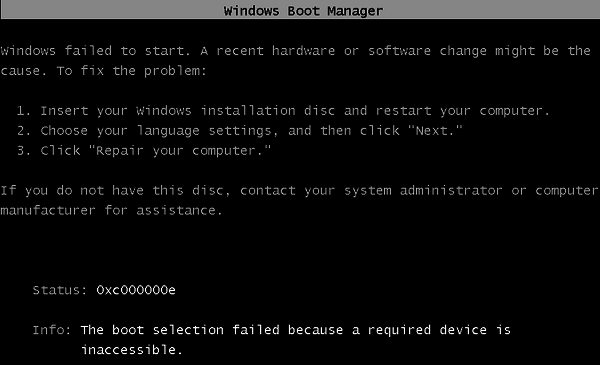
In this case, we need to reset and choose the secondary plex.
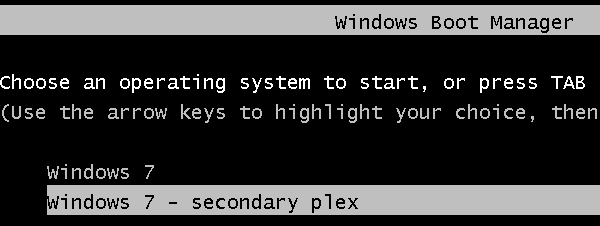
How to fix a collapsed software RAID 1
We must replace the HDD that has failed with a new one, as soon as possible.
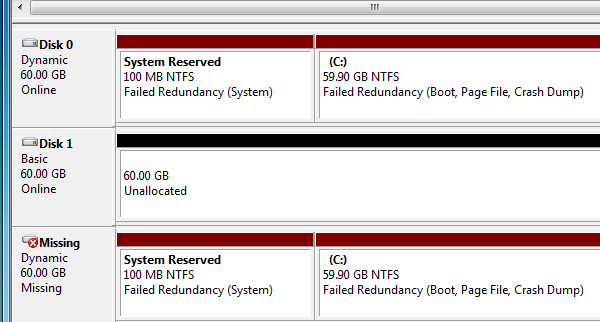
Then, before we remake the array, we take a complete backup of any essential data from the working disk, preferably on an external hard drive.
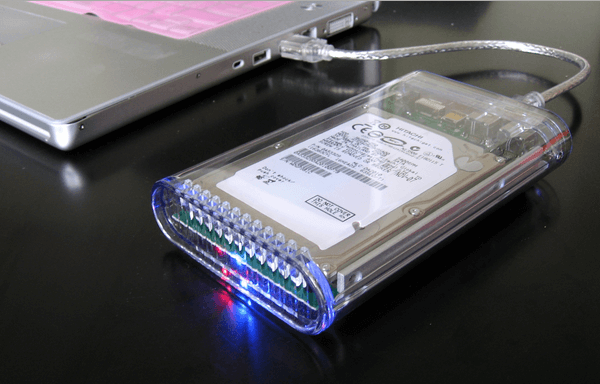
The last thing we want is for the only working disk also to crash while rebuilding the array.
After we have backed up our data, we remove the mirror...
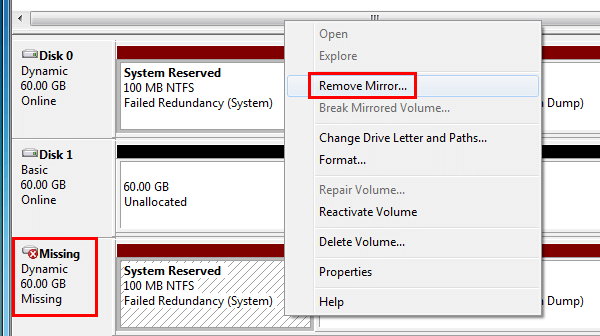
...making sure we have selected the Missing disk...
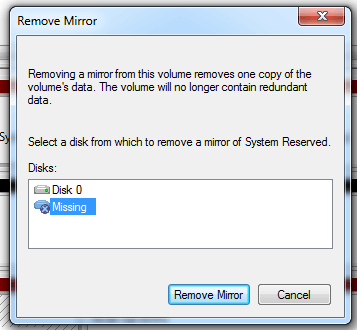
After that, the missing disk entry will disappear, and we can create the RAID with the new hard drive.
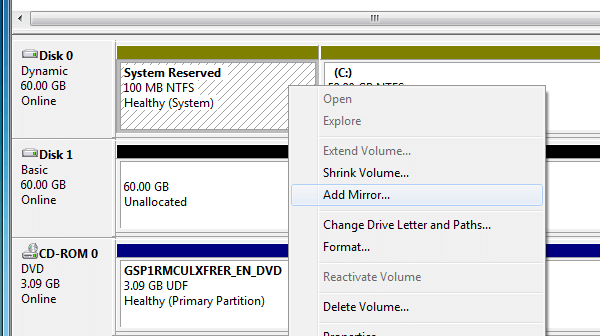
Why choose the Software RAID 1 instead of the motherboards "hardware" RAID?
Most current motherboards boast their RAID controller.
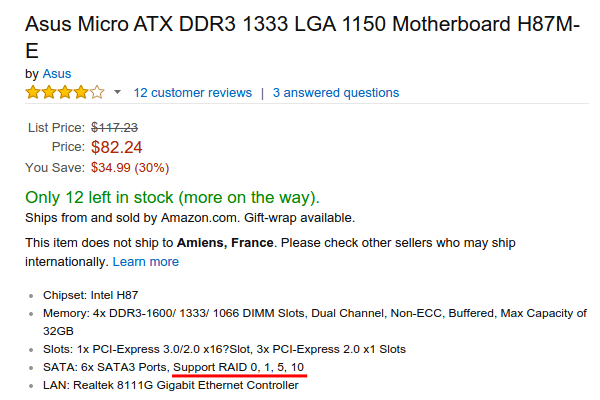
Many users think of this as a "hardware" RAID, and thus a better solution than a software RAID 1 or software RAID 5.
The thing is that motherboard RAID isn't hardware RAID. It is software RAID, run by the BIOS and the Windows drivers.
It's a worse solution than both true software and true hardware RAID, and that is why it is known as Fake RAID. You can read about it in the linked article.
The fact is that we need an expensive hardware RAID controller - upwards of $300-$400 - to get true hardware RAID. Some cheap PCI or PCI-E controllers also use Fake RAID.
All in all, software RAID 1 in Windows 7 is far from perfect, but it is the best way to get RAID 1 on our Windows 7 PC, without paying through the nose for it.
Did you have any trouble creating a software RAID 1?
If anything didn't work for you as described, leave us a comment.
Support PCsteps
Do you want to support PCsteps, so we can post high quality articles throughout the week?
You can like our Facebook page, share this post with your friends, and select our affiliate links for your purchases on Amazon.com or Newegg.
If you prefer your purchases from China, we are affiliated with the largest international e-shops:
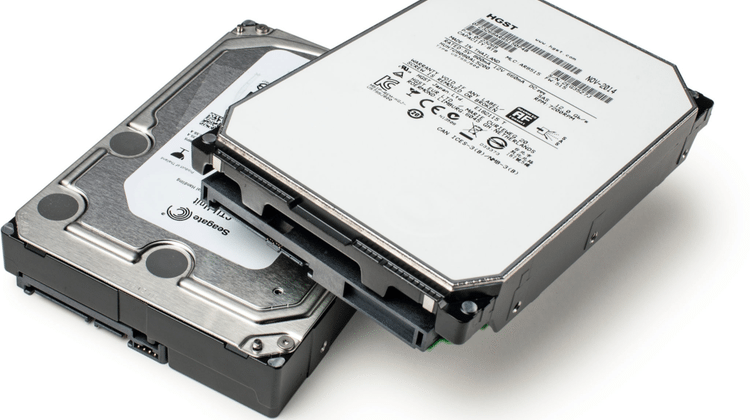



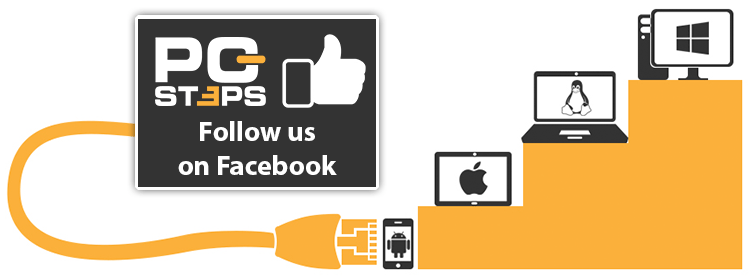
CPU do all the work on both cases...recently i had a bad experience with fake raid,bios suddenly corrupted, and i lost my raid ,on the other hand i have heard that windows software raid are not stable because of dynamic volumes...i will not spend money for hardware pci cards,it is not worth .i dont know what i have to choose,kindly tell me your opinion
I haven't heard anything about instability with dynamic volumes, and I couldn't find anything either, with a quick search.
Since this is the same method that is used in the server versions of Windows, I guess it's safe enough for home. It definitely is better than fakeraid, and an expensive controller isn't worth it.
I had no problem creating the software raid. I tested it by booting up with each drive and it worked. The only issue I had was when I put both back in after the testing and booted up, it booted fine, but said I had a missing disk and had to import the foreign disk and then I had to break the mirror and redo re-add it. I would have figured it would have rebuilt on it own. Anybody have any thoughts?
Well, since you split the RAID and booted from just one disk, its contents changed compared to the other, so it makes sense that the array was degraded.
As far as I know, RAID can't rebuild just the changed files, it needs to completely rebuild.
No BOOT DEGRADED option?
Hi - Have installed 2 equal sized new SSDs in the PCie bus. Successfully cloned complete system using Acronis software (Win 7 Ultimate O/S & all data) from HD onto one SSD. Made sure all worked properly. Then installed the 2nd SSD. Went to Win Disk Management. On the new SSD 'C' drive - right clicked 'add mirror' (RAID 1). Highlighted new SSD Disk 2. Program starts to go through the process - then stops & says ' Not enough space available'. Both disks are equal size. Both from same Mfg (Kingston HyperX Predator 480GB). Need help as to what the issue might be. Thanks in advance. Nicholas
Hi Nicholas,
Have you tried shrinking the original partition? Not much, just a few gigabytes, to see if it makes a difference on creating the RAID.
From what I understand about SSD's and SSHD's is they do not work well with RAID apps on any OS yet, I believe the industry is working on that
Well it did not quite go as well as expected.
Have had a mirror going for nearly 5 years, but it recently started acting up, causing my computer to run v e r y s l o w l y. Basically froze up, could not load any applications (but fortunately not until I had made a copy of all the files onto an external drive). So I removed what I had thought was the failed drive of the mirrored pair. I was then able to boot into a functional computer, but without access to most of my programs which were installed on the failed mirror. I was then able to get onto windows disk management to remove the mirror. Tried to re-establish the mirror with a replacement drive, but was not allowed to do so - a message about sectors not being the same size (same size drive but different manufacturer, and newer). I thought - no problem I'll just copy the files from the broken mirror (the half still in the computer) to the new drive manually, then recreate the mirror with the other (second) new drive. But I was unable to access the files on the remaining half of the original mirror - apparently it was the bad disk (even though reported healthy in Windows disk manager). Again I thought no problem I'll just swap the two physical disks from the original mirror. Apparently it does not work that way as the removed disk once reinstalled was reported as a foreign disk, and inaccessible, and the bad disk (not physically present in the computer) was reported as missing. Hmm.
Now I am copying files form by external back up to one of the new drives. Given how the mirror was acting up I hope I have everything.
Question I have is this, one disk of the two on the mirror must still be OK, the one I physically removed removed first. How do I make it so that Windows can read the files on it?
Question please..
I had Raid 1 Mirroring...it failed many times.. in my XPS9100
I finally decided to go NON RAID...I deleted the Raid Volume after yet another failure as I thought all was lost and had nothing to lose ..(I was initially going to start over with setting up Raid..but whalla..When I deleted the Raid volume on one of the two new Constellation 1 Terabyte drives to start over ..ALL my Data came back and it started booting..I was ECSTATIC!!!! SO I have two new NO RAID Drives..and don't want to wipe out my disc and programs to start over with Raid 1..... SOOOOOOOOO My question is..being that my new second drive is just shitting there...which is the better option in Windows 7 Home Premium...do I CREATE RAID VOLUME FROM EXISTING DRIVE....OR CREATE RECOVERY VOLUME FROM MASTER DRIVE (Or Both??) I do NOT want to lose my Data or start over..whch is better for me to have back up (Yes I do have an external...but I want to have a backup on ,y second Non Raid Drive!!! HELP!!!!!!! I can do either with Intel Matrix Storage Console....what should I do????
THANK-YOU... Andrew
Which One of these is my best bet with 2 Non Raid Drives??? ( want some data protection!! (Can I do both?)
I have (2) 1 Terabyte Constellation ES.3 Drives in Windows Home Premium 7 64 bit with Intel Matrix Storage console...(and I previously deleted my Raid Volume to restore my data when it crashed halfway through a Raid 1 rebuild..I thought all was lost but when I deleted raid Volume on the Master drive in CTRL + i......the data came back and booted up..I do NOT want to risk my data again by rebuilding Raid 1 and starting over...so with that said...I have these two options...which should I do?? Please!!!!
THANK-YOU so much!!!!
Create RAID Volume from Existing Hard Drive: Use this creation option when you want to preserve data on an existing hard drive and copy that data to one or more additional hard drives. This creation method, called migration, may take a few hours depending on the hard drive capacity and system workload. Once you complete the wizard, a dialog will appear that shows the migration progress. To reopen the dialog at any point during the migration process, right-click on the migrating volume in the Intel Matrix Storage Console and select 'Show Migration Progress'. Only one migration process can take place at a time. If you want to convert more than one data drive to a RAID volume, you must convert them one at a time.
•Create Recovery Volume: Use this creation option when you want to create a volume using Intel® Rapid Recover Technology. This technology copies data from a master drive to a recovery drive either continuously or on request. The master and recovery drives must span 100% of the available hard drive space of an array, and only one recovery volume can be present on a system. Note that when a recovery volume is created, no RAID volumes can be present or added to the system.
i have problem when i create RAID 1. after finish create it, i get "the operation is not supported by the object". how can i fix that problem??
> Creating a Software RAID 1 copy of an existing data disk or partition
This article is LOADED with errors. It keeps saying that you can create RAIDs with just "partitions".
False. Only entire drives can be RAIDed.
Ugh.
CHEAP form of RAID without a controller and enough SATA ports with Windows is to install LINUX Server and schmooze the RAID with VM, Linux will supply the means and firewall for RAID and Windows will benefit from the speed and redundancy will be installed as a virtual machine on (/dev/md0 as drive ??). UBUNTU SERVER supports RAID 0,1,5,6,10 and with VM or Virtualbox you can run Windows with the benefit of a fully functioning RAID without the expensive hardware. If big enough and enough drives and SATA ports I would recommend RAID 5,6 10(fastest good redundancy), set mainboard BIOS RAID to OFF so software does not fight with Linux OS over control of the array. Once this is set up even if mainboard fails you can plug the array into another machine and up and running again, my experience with RAID 10 is that it does not care what order the drives are installed, GRUB is coded as to how they will boot since every drive has a copy in case of drive failure. solution is free should you choose to take the assignment :-) have a nice day "The hardware said must have windows 8 or better, so I installed LINUX" To properly choose version of RAID google RAID Calculator and several sites will pop up, put the perimeters (drive size, capacity, number of drives. Then read the description of the layout and choose your poison) in and happy hunting.
Ubuntu Server(plus desktop if you do not like command line) + VirtualBox + Windows OS = very powerful and functional option. Supports RAID 0,1,5,6,10 . . .0 and 1 requires two drives, RAID 5 requires 3 drives minimum, RAID 6 and 10 requires at least 4 drives. Dual boot is not a very good option if you want to go from Windows to Linux or v/v without reboot, MS wants you to buy a very expensive license to give you the options most of us want, I got tired of the circus so I switched to Linux so I can do whatever I want with the software, improve it, experiment with it and no one telling me what I can and cannot use with it. .
Unraid is also an awesome software RAID and virtualization solution, which also supports VGA pass-through. You might want to check it out https://lime-technology.com/
Why make more complicated? Windows does not support RAID, wasting money and time trying to make a patchwork solution is a non starter, also still in the realm of "RENTED" software, proprietary and buggy. Installing Ubuntu (or other Linux server distro) with virtual box gives Windows access to the RAID where as Lime UnRaid is essentially a gimmick (an expensive on at that since extra Video adapter required to make it work). . .. why punish your wallet for something you can do for free ??
UnRaid also gives access to the RAID to Windows and any other OS. It is definitely not a gimmick, it is used in server installations and production environments, including the servers of Linus Media Group and the personal server of DEADMAU5.
The reason to choose UnRaid is that it is a way better solution regarding resource allocation. It can be compared to VMware vSphere, only much more user-friendly.
With Linux running and a VirtualBox VM running on top of it with Windows, you are not allocating your resources well. You end up running two OSes simultaneously, and that's rarely a good idea. With UnRaid you can have all the pros of software RAID and full resource allocation to each OS, and also the option to run two or more OSs simultaneously, if you have a good reason for it.
Purchases = additional hardware plus License fee for product, configurable by what is allowed by the manufacturer, if it does not meet the needs of the user then you spend more to get software patches with no guarantee that it will do what you need. Of course if it doesn't work you are not able to return the product once its been used, As far as all the features of RAID I am highly suspect
Linux = $0 download what you need and configure it any way you like, lots of supporting sources to get you up and running securely, efficiently, and quickly
I can hot swap and auto rebuild all day without having to consult IT to
fix issues with my machines, they run well and tell me if I have a sick
drive, attempt autorebuild and if fail it kicks the drive and you
replace it. As you can tell I hate the idea of buying anything that
requires a stepped license to use, especially when I may have to
purchase additional licenses and hardware to make it work properly. Sourceforge is one such network that has many such ideas as well as blogs and sites who have professional experience with how all of the internals work and modifications required to get where you are going.. . .. we have a name for weapons at the range that are expensive and novel, they may work well, but when you need them they fail, we call them "range toys" I think I can draw a parallel here with the Lime OS which you are still riding atop another expensive OS to get the job done.
Windows already has issues gobbling up system resources, Idle Linux box runs about .5% system resources, I do not think Windows is going to miss that from the 80% it uses doing nothing.
I prefer RAID 10 which Winders doesn't support without expensive hardware, problem with RAID 5 and RAID1 is terrible read/write performance, RAID 10 gives great redundancy and multiplies write and read speed, Linux with VM Windows would be the way to go, unless you got a thick wallet and easily part with your cash. . RAID 10 is 3 mirrored drives with 3 stripes in my case (6 x 2TB plugged directly into SATA ports, and very fast